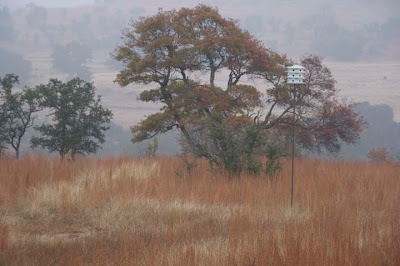
In November we had some cool days and nights, as well as some drizzle and fog. In the picture above there is rusty-red little bluestem grasses, a Texas oak turning red, and in the background, hills shrouded in fog.
It in now the second week of December, and we have had a couple of windy days so most of the leaves are down, and winter's colors dominate the wooded areas of the ranch. There are many areas in which Live oak is the dominant tree, and of course they are green all winter. The grasses are still beautiful, but their colors are not as intense as they were in October and November.
Not remembering the exact reasons for the fall color changes in tree leaves, I pulled out my botany text book to refresh my memory. I found a web site that gave me even more information about fall colors: Why Leaves Change Color. The three main factors that influence the color changes are pigments, length of night and weather. The colors of a particular species of plant in fall is a combination of its heritage and weather conditions.

The pigments in leaves are chlorophyll, carotenoids, and anthocyanins. Chlorophyll is the green pigment that is necessary for photosynthesis (making sugar from CO₂ and water using sunlight) and are found in chloroplasts of leaf cells. Carotenoids produce yellow, orange and brown colors in fruits and vegetables as well as in leaves, and anthocyanins give color to fruits such as cranberries, red apples, blueberries, strawberrries, and plums. Chlorophyll and carotenoids are found in chloroplasts throughout the growing season. When chlorophyll fades out as nights get long and temperatures go down, carotenoids get a chance to shine. Most anthocyanins, which are present in the watery liquid of plant cells are produced in fall in response to light and excess sugars that are trapped in leaves when the flow of fluids is cut off by the accumulation of cells at the base of the stem holding leaves to twigs. They too can be seen when green chlorophyll is no longer produced. That layer of cells I mentioned at the base of the leaf stem eventually cuts off all flow of water and nutrients between leaves and the rest of the plant, and the leaf falls off.
Enough of the science of color changes. This year there were some beautiful yellow, orange and red Big-tooth maples.


Some plants turn an intense red, and have names that indicate its consistent color, such as Flame-leaf sumac.

Many, but not all, of the Texas oaks turned orange or red. Some just turned brown before dropping their leaves. This one was a beautiful scarlet.

Bald cypress turn a rusty brown before their needles fall down. How long they hang onto their needles depends on weather and wind, and this year they fell down fast. Needles float in the water, and sometimes one can see beautiful images when looking down into the water underneath a cypress. In this picture we can see needles floating, green water plants in clear water, and cypress branches outlines by intense blue sky.

I'll miss the beautiful colors of fall, but there is beauty in winter. I love the shades of grey that are seen in the bare trees. Also, tree shapes are fascinating, and I've learned to recognize many different trees by their shape, and arrangement of limbs.
It is Sunday evening, and a cold front has just arrived. Rain is in the forecast, and we really need it. Stay warm, but enjoy the outdoors.
No comments:
Post a Comment